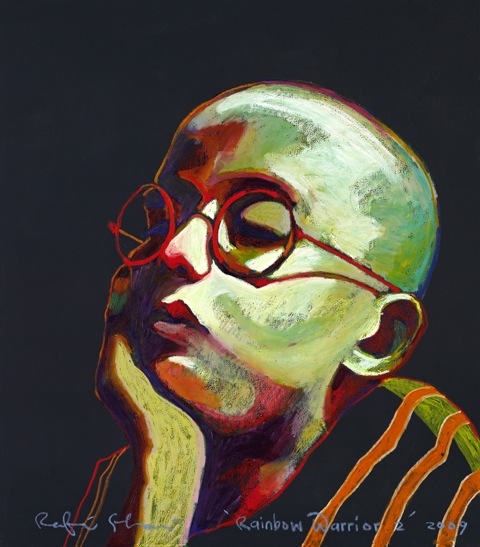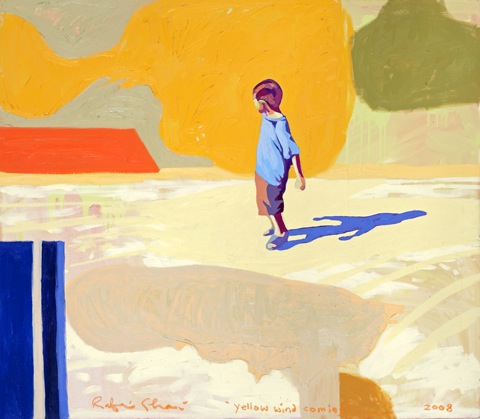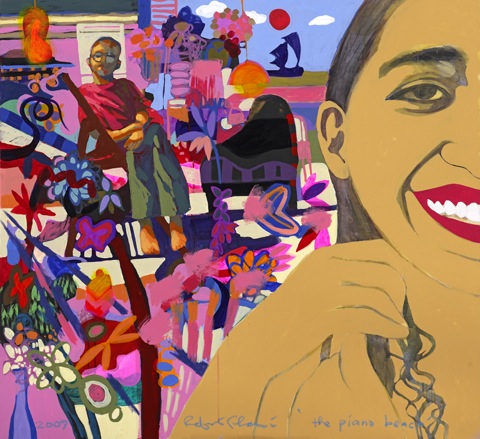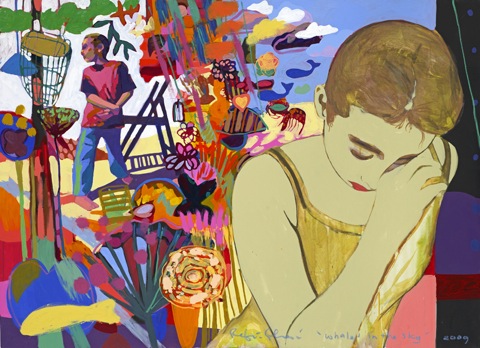


Rainbow Warrior II, 2009, Oil on canvas, 117 x 122cm
Rainbow Warrior
An exhibition of work by Rafiee Abdul Ghani,
Galeri Chandan
1 June – 2 July 2009
When the Mother Earth is sick and the animals dying there will come a tribe of peoples from all cultures, who believe in deeds, not words, and they will restore the Mother Earth to her former beauty. This Tribe will be called, the Warriors of the rainbow. Ancient Hopi prophesy.
The above text is taken from an ancient North American Hopi Indian belief. Later, the essence and meaning of that text was incorporated into William Willoya and Vinson Brown’s book Warriors of the Rainbow (1962). It is from that book that the environmentalist group – Greenpeace, borrowed the concept to give name to their first fishing vessel – Rainbow Warrior, sunk by agents of the French government in 1985. It is now the title of Rafiee Abdul Ghani’s exhibition at Bukit Damansara.
There is much to connect the increasingly organic work of the artist Rafiee Abdul Ghani to those stalwart concepts held aloft by Greenpeace and other environmentalist groups. They include the re-greening of the planet, saving threatened flora and fauna, a profound love of nature and an intrinsic belief in the preservation of our environment.
Since Rafiee Abdul Ghani’s early works – Ingatan dari Gunung (Memory of Mountains -1985) and Green Park 4 (1993), an insightful care and concern for nature’s milieu has been self evident within the artist’s works.
A thread of quiet concern links Rafiee’s entire image making, from the seeming abstract (Ingatan dari Gunung – 1985), to the expressionistic (Purple Flowers – 1997) and through to the predominantly figurative, with expressionistic abstract overtones (Yellow Wind Coming – 2008).

Yellow Wind Coming, 2008, Acrylic on canvas, 122 117 cm
It is a concern for nature, our planet, and, like a Rainbow Warrior of legend, Rafiee is intent upon giving a warning regarding man’s footprint on the planet, while also revealing the intense beauty of the world as seen through his eyes.
Over the last few years the artist has been seen searching for a method of developing figurative work, within the context of an expressionistic framework. Man, both as a concept and a reality, has been increasingly portrayed as an integral nexus for the artist’s depictions of nature, recollection and innocence.
Certainly innocence, rather than naiveté, has pervaded Rafiee’s works over the past two decades. With his nuanced painterly sophistication, the artist currently presents the perfect symbol for innocence and love – the purity of the child.

Ali’s Wonderland 1, 2009, Mixed media on canvas, 193 x 170 cm
In the artist’s works, presented at Galeri Chandan, we encounter Ali’s Wonderland 1, an obvious play on Carroll’s Alice in Wonderland. Here we see a young boy (Ali/Rafiee) wading through a life beset with nature, imaginings, flowers, butterflies, planes and bombs. It is an age of communication, but the letters remain sealed, it is an age of beauty and of butterflies as he luxuriates on the beach of time and timelessness, stretching, wondering, and pondering. Sand pulls waters to him as he is weighed by the heaviness of being, kneels and rests his head on sand, the bright sun hot on his young shoulders.
Alternately the twin fascinations of melancholia and listlessness pose the boy, as he kneels, deep in innocent thought, beside reflections of eternal nature, or with grim determination stretches, climbing to pluck jasmine flowers, which, like his future, are just beyond his reach.
The growing awareness of his Jungian symbolic internal world is all that separates the boy from the nature which surrounds him. His moodiness, his insular thought-filled reality ultimately cuts the boy off from the lush, vibrant world around him.
Ever in thought he inhabits the hanging gardens, observes geese, glares at the sun or sits enveloped in the glow of a peach moon. At times, compelled by his inherent cheekiness, the boy rests one foot on a red plastic chair and waves out to sea, growing to become aware of his gesture and its double meaning.

The Piano Beach, 2009, Acrylic on canvas, 132 x 122 cm
Thoughtful adults sit surrounded by fireflies and butterflies, as if caught in reveries by Odilon Redon (Firefly Beach – 2008), or smile towards the viewer unaware of the solemn child melding into an array of butterflies and Hockneyesque imagery (The Piano Beach – 2009).
In Whales in the Sky (2009) to some extent we are back within the realm of the Ali’s Wonderland 1, only in the foreground leans a stylised young woman, wiping a tear from her eye, she leans as if leaving, or resting from some sorrow which threatened to overwhelm her, but at the moment of painting had not succumbed yet. In the mid-ground drifts painterly paraphernalia of butterflies, flowers, fish and a variety of objects which pull the viewers eye through to the child, standing, gazing to off canvas left (viewers left).

Whales in the Sky, 2009, Acrylic on canvas, 168 x 122 cm
In the background blue whales swim in lighter blue skies, a brown aeroplane is sighted against a white backdrop. The sadness and anxiety of the painting reveals a last gasp, the moment before all is lost, before the youth of the boy is lost forever, and the penultimate moment before the ultimate extinction of the whales, forests and finally us.
Is the boy the Rainbow Warrior, who is finally preparing for battle as he gazes off canvas, is his stance that of the martial arts horse, a position of strength from which he will spring ready to save the day, and the planet? The soft despair of the woman is countered by the bold strength of the boy, hand clasping wrist. We shall never know, for the exhibition poses questions rather than provides answers, it is for us to search within our sensibilities and reconcile ourselves to what the artist Rafiee Abdul Ghani is saying through his work.
Somewhere, at the back of my mind, unbidden, two tunes danced through my consciousness as I viewed these images produced by Rafiee Abdul Ghani. There was, quite obviously you might think – Don’t Kill the Whale, by the aging British progressive rock band Yes, replete with Jon Anderson’s distinctive vocals, and the less obvious Seaside Woman by Paul McCartney’s band Wings. Why Seaside Woman, because, at times, while viewing Rafiee’s images, I could see the deft hand of the Argentine cartoonist and animator Oscar Grillo, and his flamboyantly coloured animations for both Seaside Woman (1980) and the Kia-Oraadverts (1981).
~
Yusuf Martin – As seen on NTV7 Malaysian national television and heard on BFM Radio; Philosophy graduate. Post Grad in Art History & Theory. Post Grad in Gallery Studies. English man living in Malaysia. Writer. Blogs athttp://correspondences-martin.blogspot.com/
Sorry, the comment form is closed at this time.
Many thanks for adding the images, you are obviously much better at doing so than I.
Imagine my surprise, when last night (12th June 2009)Dr Mohd Najib Ahmad Dawa, the man now in charge of the National Art Gallery, gave a speech at the above exhibition opening, most of which seemed to be taken from my article above written 2nd June 2009.
Now there is a vague possibility that Dr Mohd Najib Ahmad Dawa did exactly the same research as myself, and therefore came up with words, in English, which approximated my own. This is entirely possible, not probable, but possible.
I should feel flattered that Dr Mohd Najib Ahmad Dawa should chose to approximate my writing, however I feel cheated, as there was no mention of the above article.
I feel futher cheated that such an elevated man as Dr Mohd Najib Ahmad Dawa should not care enough about the artist, the work or the establishment in which he was speaking, to care to express original ideas about Rafiee Ghani and his work.
This is outrageous, Yusuf. I’m sorry to hear it. The guy obviously needs you to tutor him in art or hire you to be his speechwriter. He may as well have read out the URL to your essay, that would have thankfully cut his speech short.
Yusuf,
Perhaps you would like to write a letter to Dr. Najib and Balai on this matter?
Also before everyone jumps to conclusions I would just like to throw out there that many directors of institutions (not just in Malaysia) do not write their own speeches.
The plagarism, if there was any, could most likely be much further down the line.
I agree with Sharon, and this was mentioned by my wife too. Whoever was responsible for the writing is the guilty party, if indeed it was cut and paste.
As I say above there is always the vaguest of possibilities that someone did exactly the same research as me.
Salam Perpaduan dan Salam Seni.
Kami amat terharu diatas keprihatinan tuan mengenai ucapan ketua pengarah Balai Seni Lukis Negara, Dr. Mohamed Najib Ahmad Dawa yang dikatakan merujuk kepada artikel tuan. Untuk menjelaskan keadaan yang sebenar, kami muatnaikkan ucapan beliau untuk dikongsi bersama.
“(Salutations)
Ladies and gentlemen, I feel honored and privileged that I was asked to deliver a speech for tonight’s opening ceremony, especially since it’s for an old acquaintance, the painter En.Rafiee Ghani, who has come a long way since the 1980’s to be where he is today.
I’ve been keeping track of his steady rise to fame through sheer hard work, determination and artistic ingenuity, which should serve as an inspiration for us all, especially the younger generation of artists.
Ladies and gentlemen, when I found out that the title of Rafiee’s latest exhibition was called ‘Rainbow Warrior’, I imagine the works to be about muscular warriors engaging in manly pursuits and other acts of chivalry, beautifully depicted in Rafiee’s trademark, loud, bold colors and energetic, expressive strokes.
But I suspect that the artist, famous for his depiction of serene and domestic scenes through his wonderful series of works in ‘The Hanging Garden’, ‘Kebun Sultan Series’, ‘Room of Flowers’, ‘Painted Garden’ and many more would not suddenly shift his eyes on something so aggressive and violent, which is contrary to his gentle nature.
Another thought came to mind, which is the name of the ship owned by the radical environmentalist group Green Peace. This NGO has been at the fore front protesting against the rape and destruction of the environment by greedy corporations and nuclear tests by repressive governments since the 70’s till now.
But then again, our friend here is not a member of Green Peace nor are the works about the environment, the daring legendary exploits and the tragic story behind the ship itself or the on going activities of Green Peace today.
So I decided to do some research and found out that the name ‘rainbow warrior’ was inspired by a Native American mythology belonging to the ‘Hopi’ tribe about the fulfillment of a prophecy. Allow me to quote the passage which goes something like this:
“There will come a time when the Earth grows sick and when it does a tribe will gather from all the cultures of the World who believe in deed and not words. They will work to heal it…they will be known as the “Warriors of the Rainbow.”
http://en.wikipedia.org/wiki/warriors_of_the_rainbow.
I doubt that Rafiee, who is a practicing Muslim, would work towards the fulfillment of the prophecies of the Hopi’s instead of his own chosen faith. So strike that thought out as well.
I know that Rafiee, in his artist statement, has asked the viewers not to be concern with meaning, ‘that to appreciate modern contemporary art, one is to put meaning aside’. The well traveled painter has stressed that his works are about ‘feelings’. Take for example a quotable quote from him” I am not painting melons or mangoes. I am painting my ‘feelings’ about melons and mangoes’.
So after looking at his latest series of paintings and reading the curator’s essay, I feel I kind of understand what he is trying to say through his depictions of children, especially of his sons and his own nostalgic trip down memory lane captured in colorful Kodak moments. Yes, the feelings of happiness and contentment are evident, but an expression of hope, freedom and right to dream, and to the fulfillment of those dreams are also present.
Ladies and gentlemen, allow me to elaborate. As adults our heads are made cunning and our hearts become hard through life’s harsh experiences and disappointments. But Rafie, as though through his works are telling us that if we were to see the world again through the child’s innocent eyes and feel with the child’s pure heart, we will see that ’life is good and everything is alright’.
I see the works on display at Galeri Chandan tonight as a form of dedication to all the rainbow warriors within us all who will ‘Believe in deeds and not words’, who will work towards the betterment of mankind and for the future generations to come. So let open your eyes, minds and hearts to these special, intimate moments and be inspire to see that ‘ life is good and everything is alright’.
Thank You.”
Satu Malaysia-
Rakyat didahulukan, Pencapaian diutamakan.
‘most of which seemed to be taken from my article above written 2nd June 2009.’
– Y.M
Dude, the director’s speech reads pretty differently. Mmm just that both of you referred to the great Wiki goddess huh?
Ponder over the harm you are doing to yourself and the utter foolishness of your action. The only thing that you will achieve is misery. Your evil desire is not going to change anything except to make you burn from within and to destroy your good deeds. Praise the person you are jealous over in front of others. Do this even though you have to force yourself to do it. Make dua for the person you are jealous of as much as possible. Ask Allah Ta’ala to protect the person’s bounties for him, increase it and grant him barakah therein. Make salaam to him often. Occasionally give him some gift. Insha Allah by adopting the above remedies, the terrible evil of jealousy will be cleaned from one’s heart. One will also find happiness in this world and one’s good deeds will not be destroyed.